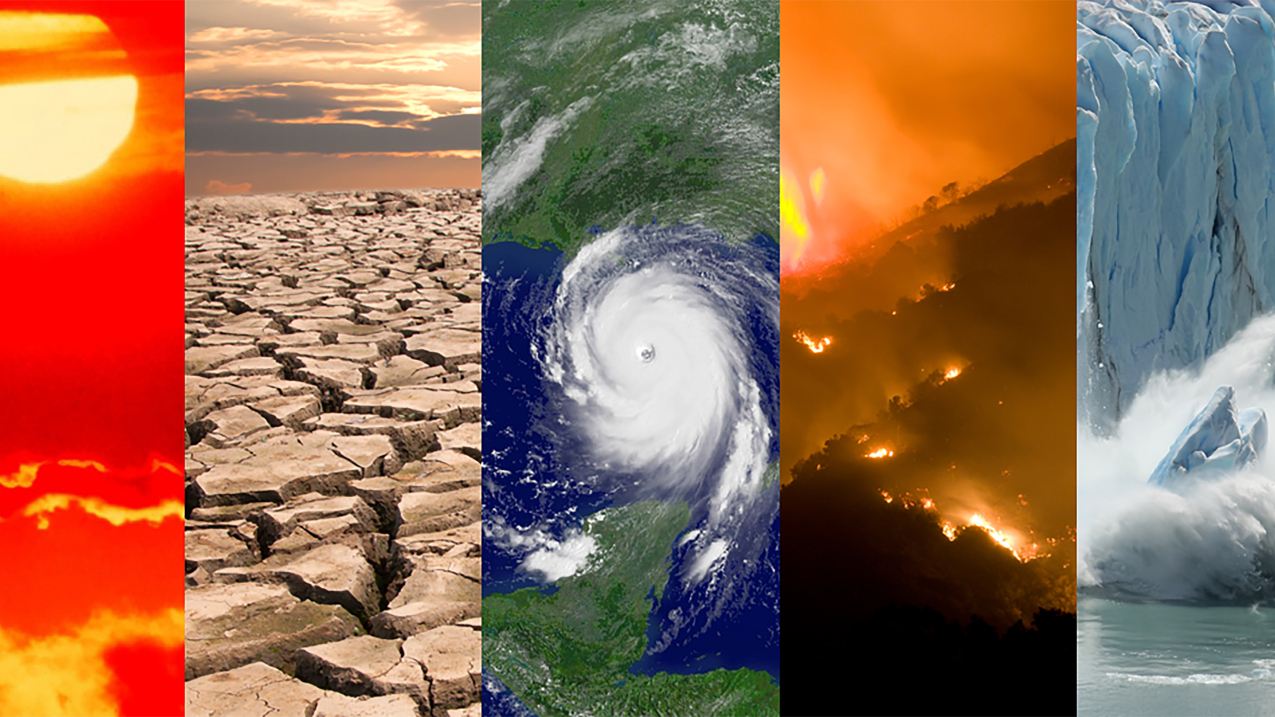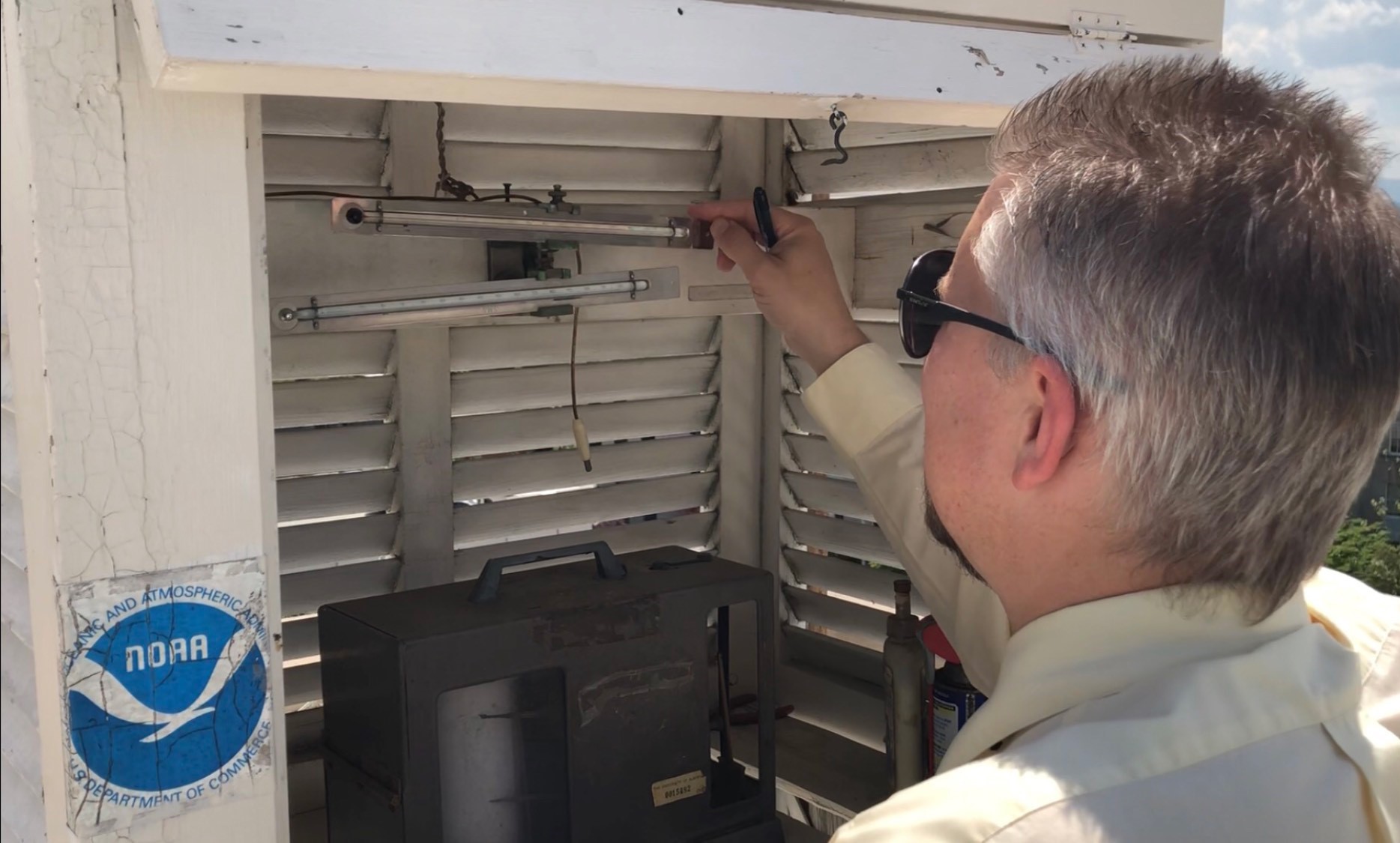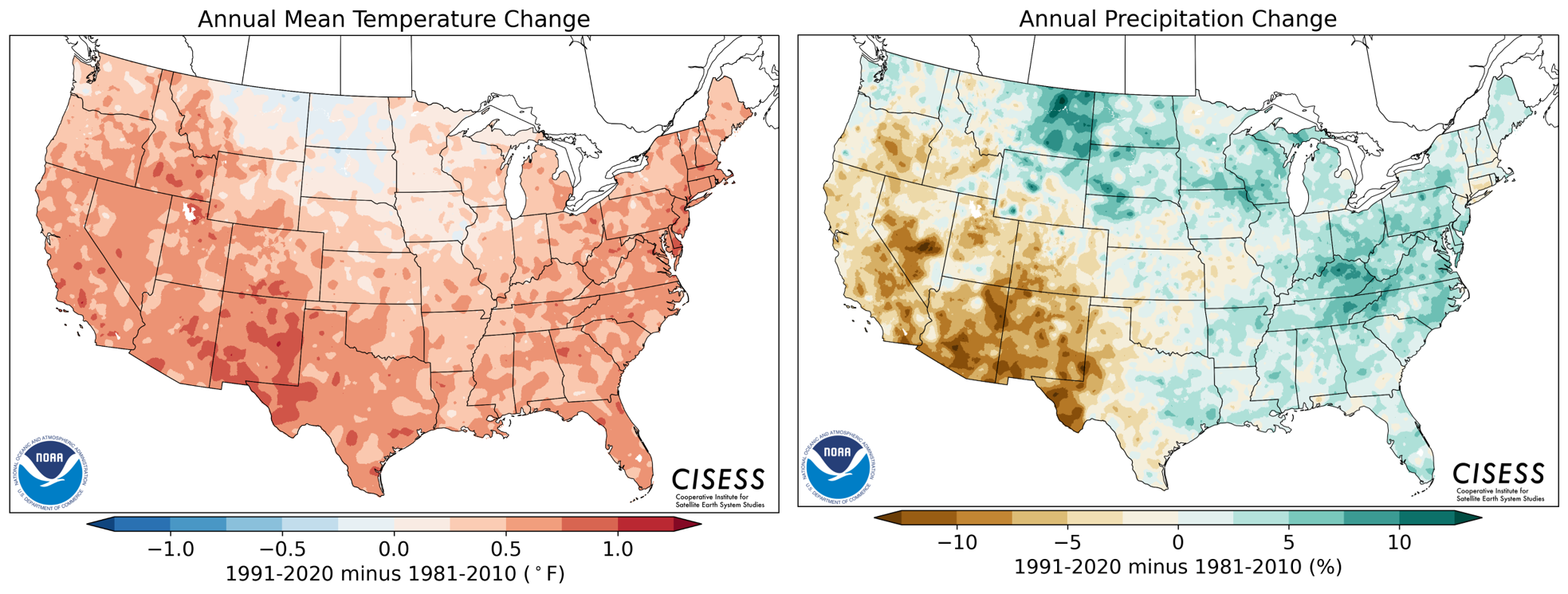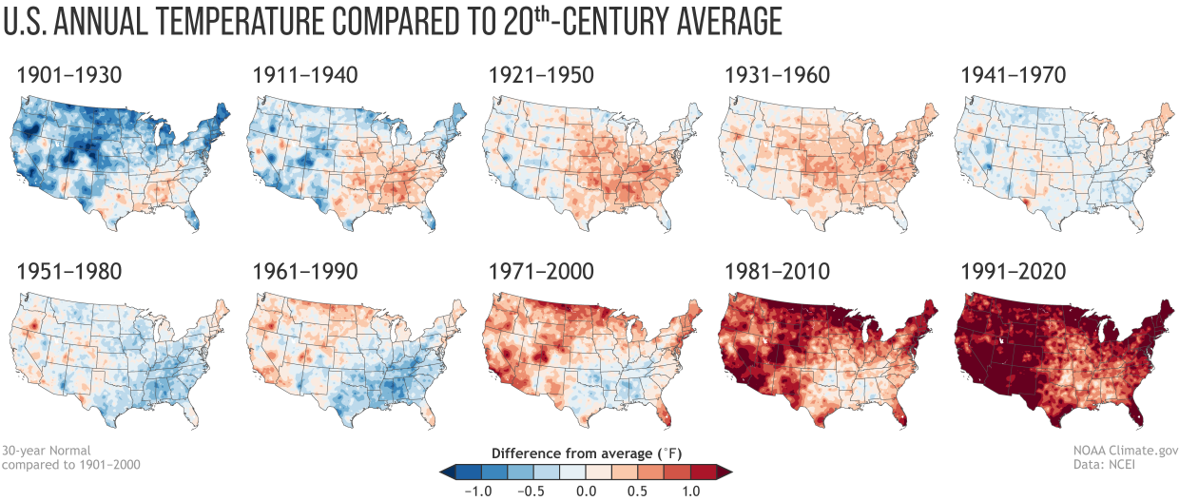
A collage of typical climate and weather-related events: heatwaves, drought, hurricanes, wildfires and changes in sea ice coverage. (Image credit: NOAA)
Understanding Climate Normals
What are Climate Normals?
How are Climate Normals Calculated?
What are the changes in the 1991-2020 update?
What do Climate Normals say—and don’t say—about climate change?
“Today’s high temperature was 85 degrees, that’s 5 degrees warmer than normal.”
You’ve probably heard your local weather forecaster say something similar in her evening broadcast. But, how did they know what temperature is considered “normal” on that day?
NOAA’s Climate Normals offer an answer. Climate Normals are 30-year averages for climate variables like temperature and precipitation. They provide a baseline that allows us to compare a location’s current weather to the average weather that location would expect to see — whether a particular day is cooler or warmer than normal, if a particular month is wetter than normal, or if the growing season is longer than normal.
Normals are critical for characterizing current weather and climate, but they also have a wide scope of applications beyond standard weather forecasts:
- Drought assessment. Climate Normals help assess drought conditions across the nation for the United States Drought Monitor, which is used by Federal, state, local, and tribal decision makers to trigger drought responses.
- Freeze risk. Farmers and gardeners plan their crops, growing season, and production schedules based on local Climate Normals, which include the average first and last freeze dates.
- Energy. For assessing energy usage, power and utility companies monitor heating and cooling degree-days and compare weather forecasts to a location’s Climate Normals.
- Snow. Local governments use normal snowfall for winter budgetary and operations planning, including for snow plows and road salt. Knowing a location’s normal mountain snowpack is also critical for planning water resources for the warmer seasons.
- Travel. Travelers can use a location’s Climate Normals to guide their vacation packing and planning. Travel agencies and Chambers of Commerce can look to the Climate Normals for scheduling and promotional purposes.
For the United States, NOAA’s National Center for Environmental Information (NCEI) is the official source of the Climate Normals.
NCEI updates the Climate Normals every 10 years, in accordance with the World Meteorological Organization offsite link, which mandates that each of its member nations compute these 30-year averages and recommends an update each decade. The latest 1991–2020 U.S. Climate Normals are an update to the Normals for the previous 3 decades, 1981-2010.
NOAA’s Climate Normals are statistical calculations of weather observations — such as temperature, precipitation and snowfall — from approximately 15,000 federal weather stations across the United States and its territories. Thousands of citizen scientists who collect local weather observations across the country also contributed to the dataset.

It’s important to understand that NOAA’s Climate Normals are not simple 30-year averages of weather observations. NOAA’s climate scientists don’t calculate Normals by adding up 30 years’ worth of weather data and dividing by 30. Of the thousands of stations around the country, some occasionally have missing weather observations, need updated instruments or have changed locations over the course of the last decade. Therefore, Normals are complex statistical calculations that ensure they consistently and accurately represent the full 30-year U.S. climate period.
The nation is generally warmer and wetter, but not everywhere.
An analysis of the updated 1991-2020 Climate Normals shows that the Normals are generally warmer than 1981-2010 in most seasons and most regions of the United States—but there are exceptions:
- Notably, in the North Central U.S., including parts of Montana, the Dakotas, and Minnesota, temperatures are somewhat cooler than those based on 1981–2010, especially in the late winter and spring seasons.
- Much of the Southeast is now cooler in November than it was during the last Normals update, despite October and December being warmer. Precipitation Normals across the U.S. also changed for 1991–2020, with large increases in precipitation in the Southeast and North Central United States.
- The U.S. West has also seen distinct seasonal shifts in its precipitation patterns, while the Southwest has generally become drier.
- Along with the updated climate information, there are new additions in the 1991-2020 Climate Normals that include several small changes to how the Normals are calculated.

NOAA also for the first time this year produced a set of 15-year Climate Normals (2006-2020) to meet the needs of specific sectors like energy and construction. In the coming months, NOAA will release richly-detailed monthly Normals data for the contiguous U.S., as well as develop new tools and methods to access the data.
Updated Normals bring climate change into focus.
Climate Normals are routinely updated every 10 years because scientists want to give the best estimate for today’s climate. Normals provide us with a window to see climate change in action, to measure its effects, and to adjust our decision-making today.
To examine long-term climate change, NOAA uses the 20th-century average (1901-2000). If we compare the 1991-2020 annual temperature Normals to the 20th-century average, we see warming everywhere across the map. No region in the U.S. is cooler than it was during the 20th century, and much of the West and Northeast are one to two degrees warmer. The nation’s midsection — from the Gulf of Mexico to the Great Lakes — did not warm as much as other parts of the country due to a 5-to-15% increase in precipitation over the 20th-century average.

The bottom line: These new 1991-2020 Climate Normals are a better baseline for the climate right now. Climate will continue to change in the U.S. over this decade, however, so NOAA will update the Normals again in 2031.
“Today’s high temperature was 85 degrees, that’s 5 degrees warmer than normal.”
You’ve probably heard your local weather forecaster say something similar in her evening broadcast. But, how did they know what temperature is considered “normal” on that day?
NOAA’s Climate Normals offer an answer. Climate Normals are 30-year averages for climate variables like temperature and precipitation. They provide a baseline that allows us to compare a location’s current weather to the average weather that location would expect to see — whether a particular day is cooler or warmer than normal, if a particular month is wetter than normal, or if the growing season is longer than normal.
Normals are critical for characterizing current weather and climate, but they also have a wide scope of applications beyond standard weather forecasts:
- Drought assessment. Climate Normals help assess drought conditions across the nation for the United States Drought Monitor, which is used by Federal, state, local, and tribal decision makers to trigger drought responses.
- Freeze risk. Farmers and gardeners plan their crops, growing season, and production schedules based on local Climate Normals, which include the average first and last freeze dates.
- Energy. For assessing energy usage, power and utility companies monitor heating and cooling degree-days and compare weather forecasts to a location’s Climate Normals.
- Snow. Local governments use normal snowfall for winter budgetary and operations planning, including for snow plows and road salt. Knowing a location’s normal mountain snowpack is also critical for planning water resources for the warmer seasons.
- Travel. Travelers can use a location’s Climate Normals to guide their vacation packing and planning. Travel agencies and Chambers of Commerce can look to the Climate Normals for scheduling and promotional purposes.
For the United States, NOAA’s National Center for Environmental Information (NCEI) is the official source of the Climate Normals.
NCEI updates the Climate Normals every 10 years, in accordance with the World Meteorological Organization offsite link, which mandates that each of its member nations compute these 30-year averages and recommends an update each decade. The latest 1991–2020 U.S. Climate Normals are an update to the Normals for the previous 3 decades, 1981-2010.
NOAA’s Climate Normals are statistical calculations of weather observations — such as temperature, precipitation and snowfall — from approximately 15,000 federal weather stations across the United States and its territories. Thousands of citizen scientists who collect local weather observations across the country also contributed to the dataset.

It’s important to understand that NOAA’s Climate Normals are not simple 30-year averages of weather observations. NOAA’s climate scientists don’t calculate Normals by adding up 30 years’ worth of weather data and dividing by 30. Of the thousands of stations around the country, some occasionally have missing weather observations, need updated instruments or have changed locations over the course of the last decade. Therefore, Normals are complex statistical calculations that ensure they consistently and accurately represent the full 30-year U.S. climate period.
The nation is generally warmer and wetter, but not everywhere.
An analysis of the updated 1991-2020 Climate Normals shows that the Normals are generally warmer than 1981-2010 in most seasons and most regions of the United States—but there are exceptions:
- Notably, in the North Central U.S., including parts of Montana, the Dakotas, and Minnesota, temperatures are somewhat cooler than those based on 1981–2010, especially in the late winter and spring seasons.
- Much of the Southeast is now cooler in November than it was during the last Normals update, despite October and December being warmer. Precipitation Normals across the U.S. also changed for 1991–2020, with large increases in precipitation in the Southeast and North Central United States.
- The U.S. West has also seen distinct seasonal shifts in its precipitation patterns, while the Southwest has generally become drier.
- Along with the updated climate information, there are new additions in the 1991-2020 Climate Normals that include several small changes to how the Normals are calculated.

NOAA also for the first time this year produced a set of 15-year Climate Normals (2006-2020) to meet the needs of specific sectors like energy and construction. In the coming months, NOAA will release richly-detailed monthly Normals data for the contiguous U.S., as well as develop new tools and methods to access the data.
Updated Normals bring climate change into focus.
Climate Normals are routinely updated every 10 years because scientists want to give the best estimate for today’s climate. Normals provide us with a window to see climate change in action, to measure its effects, and to adjust our decision-making today.
To examine long-term climate change, NOAA uses the 20th-century average (1901-2000). If we compare the 1991-2020 annual temperature Normals to the 20th-century average, we see warming everywhere across the map. No region in the U.S. is cooler than it was during the 20th century, and much of the West and Northeast are one to two degrees warmer. The nation’s midsection — from the Gulf of Mexico to the Great Lakes — did not warm as much as other parts of the country due to a 5-to-15% increase in precipitation over the 20th-century average.

The bottom line: These new 1991-2020 Climate Normals are a better baseline for the climate right now. Climate will continue to change in the U.S. over this decade, however, so NOAA will update the Normals again in 2031.


